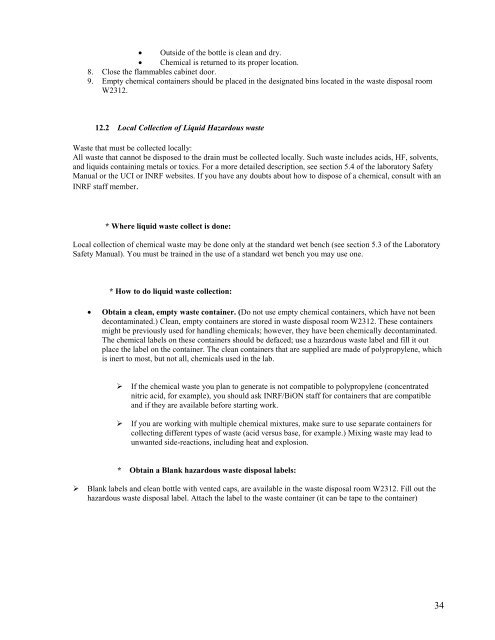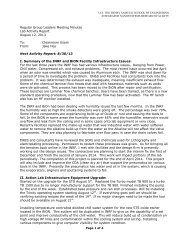Download Lab Safety Manual - Integrated Nanosystems Research ...
Download Lab Safety Manual - Integrated Nanosystems Research ...
Download Lab Safety Manual - Integrated Nanosystems Research ...
Create successful ePaper yourself
Turn your PDF publications into a flip-book with our unique Google optimized e-Paper software.
• Outside of the bottle is clean and dry.<br />
• Chemical is returned to its proper location.<br />
8. Close the flammables cabinet door.<br />
9. Empty chemical containers should be placed in the designated bins located in the waste disposal room<br />
W2312.<br />
12.2 Local Collection of Liquid Hazardous waste<br />
Waste that must be collected locally:<br />
All waste that cannot be disposed to the drain must be collected locally. Such waste includes acids, HF, solvents,<br />
and liquids containing metals or toxics. For a more detailed description, see section 5.4 of the laboratory <strong>Safety</strong><br />
<strong>Manual</strong> or the UCI or INRF websites. If you have any doubts about how to dispose of a chemical, consult with an<br />
INRF staff member.<br />
* Where liquid waste collect is done:<br />
Local collection of chemical waste may be done only at the standard wet bench (see section 5.3 of the <strong>Lab</strong>oratory<br />
<strong>Safety</strong> <strong>Manual</strong>). You must be trained in the use of a standard wet bench you may use one.<br />
* How to do liquid waste collection:<br />
• Obtain a clean, empty waste container. (Do not use empty chemical containers, which have not been<br />
decontaminated.) Clean, empty containers are stored in waste disposal room W2312. These containers<br />
might be previously used for handling chemicals; however, they have been chemically decontaminated.<br />
The chemical labels on these containers should be defaced; use a hazardous waste label and fill it out<br />
place the label on the container. The clean containers that are supplied are made of polypropylene, which<br />
is inert to most, but not all, chemicals used in the lab.<br />
‣ If the chemical waste you plan to generate is not compatible to polypropylene (concentrated<br />
nitric acid, for example), you should ask INRF/BiON staff for containers that are compatible<br />
and if they are available before starting work.<br />
‣ If you are working with multiple chemical mixtures, make sure to use separate containers for<br />
collecting different types of waste (acid versus base, for example.) Mixing waste may lead to<br />
unwanted side-reactions, including heat and explosion.<br />
* Obtain a Blank hazardous waste disposal labels:<br />
‣ Blank labels and clean bottle with vented caps, are available in the waste disposal room W2312. Fill out the<br />
hazardous waste disposal label. Attach the label to the waste container (it can be tape to the container)<br />
34



